The Design and Performance Analysis of a 15 g/mol Helium–Xenon Mixture Centrifugal Compressor
Abstract
1. Introduction
2. Design of Helium–Xenon Mixed Centrifugal Compressor
2.1. Physical Properties of Helium–Xenon Mixture
2.2. Preliminary Design Model of Centrifugal Compressor
2.3. Analysis of Some Sensitive Parameters of the Compressor
2.4. Volute Design
3. Numerical Methods
3.1. Grid Division
3.2. Numerical Simulation and Boundary Conditions
4. Results and Analysis
4.1. The Internal Flow of the Impeller
4.2. Analysis of the Whole Machine with Volute
4.2.1. Design Point Analysis
4.2.2. Analysis near the Stall Point
4.2.3. Analysis of near the Blockage Point
5. Conclusions
- (1)
- Under the inlet conditions of Tin = 400 K, Pin = 701.9 KPa, and operating flow m = 0.8657 in the closed Brayton cycle power system, the pressure ratio of the helium–xenon compressor designed in this study is 1.368, and the isentropic efficiency is 83.94%, which is 2.09% higher than that of the prototype helium–xenon compressor, and the polytropic efficiency is 1.1% higher.
- (2)
- Under the same compressor outlet conditions, the stable working range of the designed compressor is widened, the compressor flow margin is increased by 33.27%, and the pressure ratio at the design point is increased by 9.2%.
- (3)
- Impeller loss mainly comes from the channel vortex formed by the mixing of tip leakage flow and the fluid in the channel, and this ratio gradually increases with the decrease in working conditions, and the high-entropy region at the downstream tip near the stall point occupies 1/3 of the channel.
- (4)
- In the volute-collecting section, the loss of the arbitrary cross-section increases with the increase in the φ angle, but at the near stall point and the near blockage point of the compressor, the loss of φ = 45° cross-section in the volute-collecting section is higher than that at other angles in the channel from φ = 90° to φ = 360°, and the loss of the volute tongue is high. Finally, the influence on compressor performance is intensified with the increase in compressor speed.
Author Contributions
Funding
Data Availability Statement
Acknowledgments
Conflicts of Interest
Abbreviations
| α2 | Flow outlet angle, °. |
| β1 | The inlet angle of the blade, °. |
| β2 | Impeller outlet installation angle, °. |
| η | Isentropic efficiency. |
| ηp | Polytropic efficiency. |
| π | Total pressure ratio. |
| πs | Static–pressure ratio. |
| ρ | Density, kg/m3. |
| σ | Slip coefficient. |
| φ | The angle between the volute cross-section and 0°, °. |
| Bex | Diffuser outlet height, mm. |
| B2 | The impeller exit height, mm. |
| b | The axial width of the volute inlet, mm. |
| C | Absolute velocity, m/s. |
| Ct2 | The tangential velocity of the impeller outlet, m/s. |
| Cm2 | The meridian velocity of the impeller outlet, m/s. |
| Cpt | Total pressure loss coefficient. |
| D2 | The diameter of the impeller outlet, mm. |
| LAM2 | Exit swirl coefficient. |
| m | Mass flow, kg/s. |
| N | Revolution, r/min. |
| Pin | The compressor inlet pressure, KPa. |
| Pout | The compressor outlet pressure, KPa. |
| PHi | Impeller inlet rake angle, °. |
| Q | The volume rate of flow, m3/s. |
| R1t/R1h | Impeller rim/hub radius ratio. |
| Rex | Diffuser outlet diameter, mm. |
| R2 | Diameter at the outlet of an impeller, mm. |
| r | Radius, mm. |
| Sm | The flow margin. |
| T | Temperature, K. |
| Kin | The compressor inlet temperature, K. |
| U | Circumferential speed, m/s. |
| U2 | The Circumferential velocity of the impeller outlet, mm. |
| W | Relative velocity, m/s. |
| Z | Number of leaves. |
References
- Frost, T.H.; Anderson, A.; Agnew, B. A Hybrid Gas Turbine Cycle (Brayton/Ericsson): An Alternative to Conventional Combined Gas and Steam Turbine Power Plant. Proc. Inst. Mech. Eng. Part A J. Power. 1997, 211, 121–131. [Google Scholar] [CrossRef]
- McDonald, C.F. Helium Turbomachinery Operating Experience from Gas Turbine Power Plants and Test Facilities. Appl. Therm. Eng. 2012, 44, 108–142. [Google Scholar] [CrossRef]
- Golovko, V.F.; Dmttrieva, I.V.; Kodochigov, N.G.; Kuzavkov, N.G. Features of Adapting Gas Turbine Cycle and Heat Exchangers for HTGRs; International Atomic Energy Agency: Vienna Austria, 2001; pp. 63–74. ISSN 1011-4289. Available online: https://www.osti.gov/etdeweb/servlets/purl/20198170 (accessed on 17 July 2024).
- Ribeiro, G.B.; Braz Filho, F.A.; Guimarães, L.N.F. Thermodynamic Analysis and Optimization of a Closed Regenerative Brayton Cycle for Nuclear Space Power Systems. Appl. Therm. Eng. 2015, 90, 250–257. [Google Scholar] [CrossRef]
- Longstaff, R.; Bond, A. The SKYLON Project. In Proceedings of the 17th AIAA International Space Planes and Hypersonic Systems and Technologies. Conferences, San Francisco, CA, USA, 11–14 April 2011; pp. 2011–2244. [Google Scholar]
- Najjar, Y.S.H.; Zaamout, M.S. Comparative Performance of Closed Cycle Gas Turbine Engine with Heat Recovery Using Different Gases. Heat Recovery Syst. CHP 1992, 12, 489–495. [Google Scholar] [CrossRef]
- Al-attab, K.A.; Zainal, Z.A. Externally Fired Gas Turbine Technology: A Review. Appl. Energy 2015, 138, 474–487. [Google Scholar] [CrossRef]
- Kim, Y.M.; Kim, C.G.; Favrat, D. Transcritical or Supercritical CO2 Cycles Using Both Low- and High-Temperature Heat Sources. Energy 2012, 43, 402–415. [Google Scholar] [CrossRef]
- Olumayegun, O.; Wang, M.; Kelsall, G. Closed-Cycle Gas Turbine for Power Generation: A State-of-the-Art Review. Fuel 2016, 180, 694–717. [Google Scholar] [CrossRef]
- Tian, Z.; Zheng, Q.; Malik, A.; Jia, X.; Jiang, B. Effect of the Specific Heat Ratio on Transonic Axial Compressor Rotor Performances. Appl. Therm. Eng. 2019, 148, 307–315. [Google Scholar] [CrossRef]
- El-Genk, M.S.; Tournier, J.-M. Noble Gas Binary Mixtures for Gas-Cooled Reactor Power Plants. Nucl. Eng. Des. 2008, 238, 1353–1372. [Google Scholar] [CrossRef]
- Tournier, J.-M.; El-Genk, M.S.; Gallo, B. Best Estimates of Binary Gas Mixtures Properties for Closed Brayton Cycle Space Applications. In Proceedings of the 4th International Energy Conversion Engineering Conference (IECEC), San Diego, CA, USA, 26–29 June 2006; p. 4154. [Google Scholar]
- El-Genk, M.S.; Gallo, B.M. High-Power Brayton Rotating Unit for Reactor and Solar Dynamic Power Systems. J. Propuls. Power 2010, 26, 167–176. [Google Scholar] [CrossRef]
- Malik, A.; Zheng, Q.; Qureshi, S.R.; Zaidi, A.A.; Yaqoob, T.; Aziz, A. Effect of Helium Xenon as Working Fluid on Centrifugal Compressor of Power Conversion Unit of Closed Brayton Cycle Power Plant. Int. J. Hydrogen Energy 2021, 46, 7546–7557. [Google Scholar] [CrossRef]
- Gallo, B.M.; El-Genk, M.S.; Tournier, J.-M. Compressor and Turbine Models of Brayton Units for Space Nuclear Power Systems. AIP Conf. Proc. 2007, 880, 472–482. [Google Scholar]
- Dunn, J.H. Post-Test Inspection of Three Brayton Rotating Units—NASA Technical Reports Server (NTRS-TM-X-67841). Available online: https://ntrs.nasa.gov/archive/nasa/casi.ntrs.nasa.gov/19710015891.pdf (accessed on 17 July 2024).
- AIRESEARCH. Design and Fabrication of a High-Performance Brayton-Cycle Compressor Research Package Final Report, (APS-5109-R). 1965. Available online: https://ntrs.nasa.gov/citations/19660009882 (accessed on 17 July 2024).
- AIRESEARCH. Design and Fabrication of a Brayton-Cycle Turbine Research Package, (NASA-CR-54367). 1965. Available online: https://ntrs.nasa.gov/citations/19660014298 (accessed on 17 July 2024).
- Zhang, S.; Jiang, Y.; Lin, H.; Zheng, Q. Effects of splitter blade length and circumferential position on performance of helium-xenon centrifugal compressor. J. Eng. Therm. Energy Power 2022, 37, 49–56+64. [Google Scholar]
- Wang, G.; Liu, X.; Gao, J.; Zheng, Q. Influence of form of tip gap on aerodynamic performance of centrifugal compressor using mixture of helium and xenon. J. Aerosp. Power 2020, 35, 1304–1314. [Google Scholar]
- Liu, X. Investigation on Aerodynamic Design and Flow Characteristics of Centrifugal Compressor Using Helium and Xenon. Master, Harbin Engineering University. 2019. Available online: https://www.doc88.com/p-90229358618595.html (accessed on 17 July 2024).
- Yuan, Z.; Zheng, Q.; Yue, G.; Jiang, Y. Performance Evaluation on Radial Turbines with Potential Working Fluids for Space Closed Brayton Cycle. Energy Convers. Manag. 2021, 243, 114368. [Google Scholar] [CrossRef]
- Gallo, B.M.; El-Genk, M.S. Brayton Rotating Units for Space Reactor Power Systems. Energy Convers. Manag. 2009, 50, 2210–2232. [Google Scholar] [CrossRef]
- Tournier, J.-M.P.; El-Genk, M.S. Properties of Noble Gases and Binary Mixtures for Closed Brayton Cycle Applications. Energy Convers. Manag. 2008, 49, 469–492. [Google Scholar] [CrossRef]
- Zhang, S.-W. Optimal Design of Helium Xenon Centrifugal Compressor and Experimental System Simulation Research; Harbin Engineering University Harbin: Harbin, China, 2023. [Google Scholar]
- Japikse, D. Centrifugal Compressor Design and Performance; Concepts ETI: Wilder, VT, USA, 1996. [Google Scholar]
- Stahler, A.F. The slip factor of a radially bladed centrifugal compressor. Trans. ASME J. Eng. Power Ser. A 1959, 87, 181. [Google Scholar] [CrossRef]
- Dixon, S.L.; Hall, C.A. (Eds.) Fluid Mechanics and Thermodynamics of Turbomachinery. In Fluid Mechanics and Thermodynamics of Turbomachinery, 7th ed.; Elsevier: Amsterdam, The Netherlands, 2014; pp. 529–537. [Google Scholar]


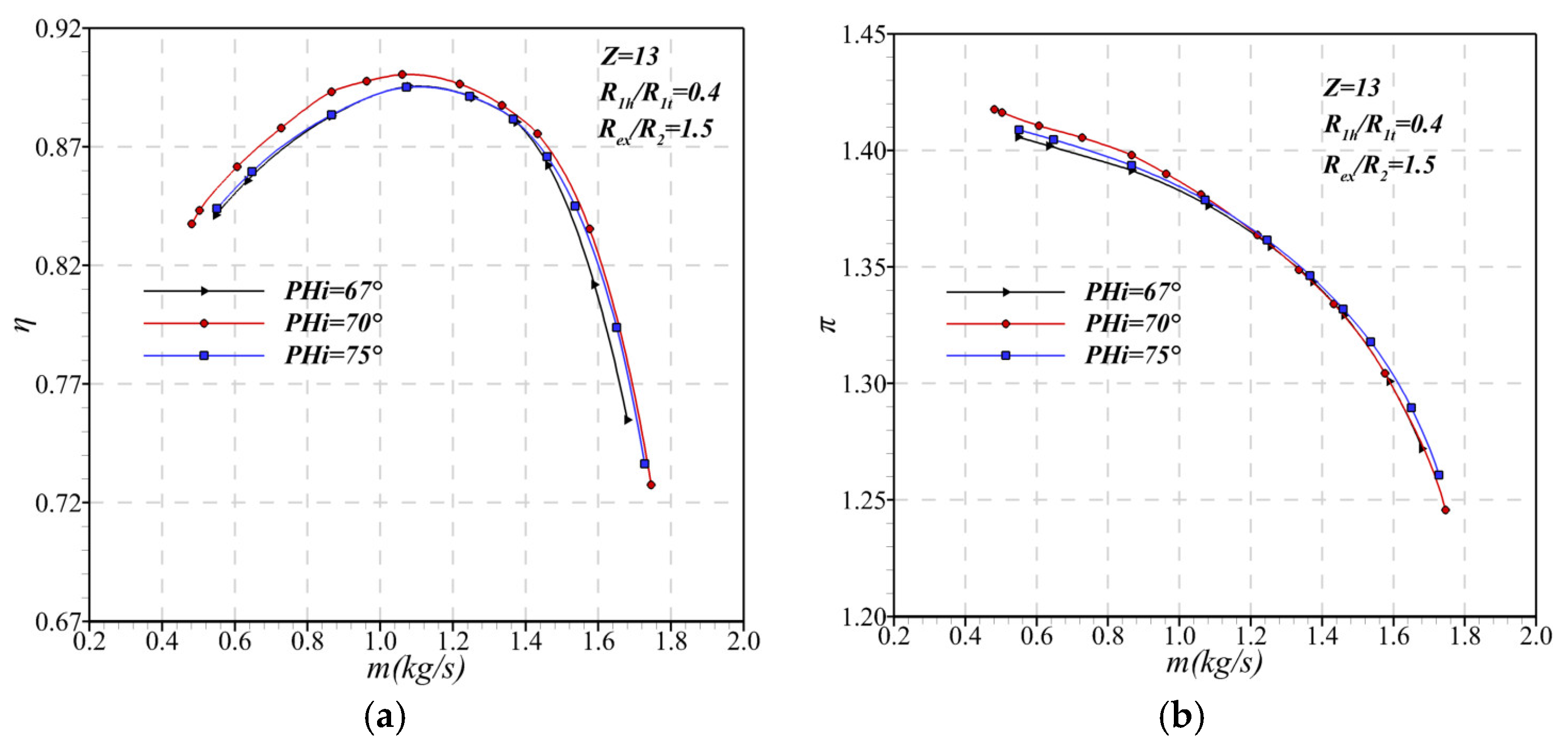

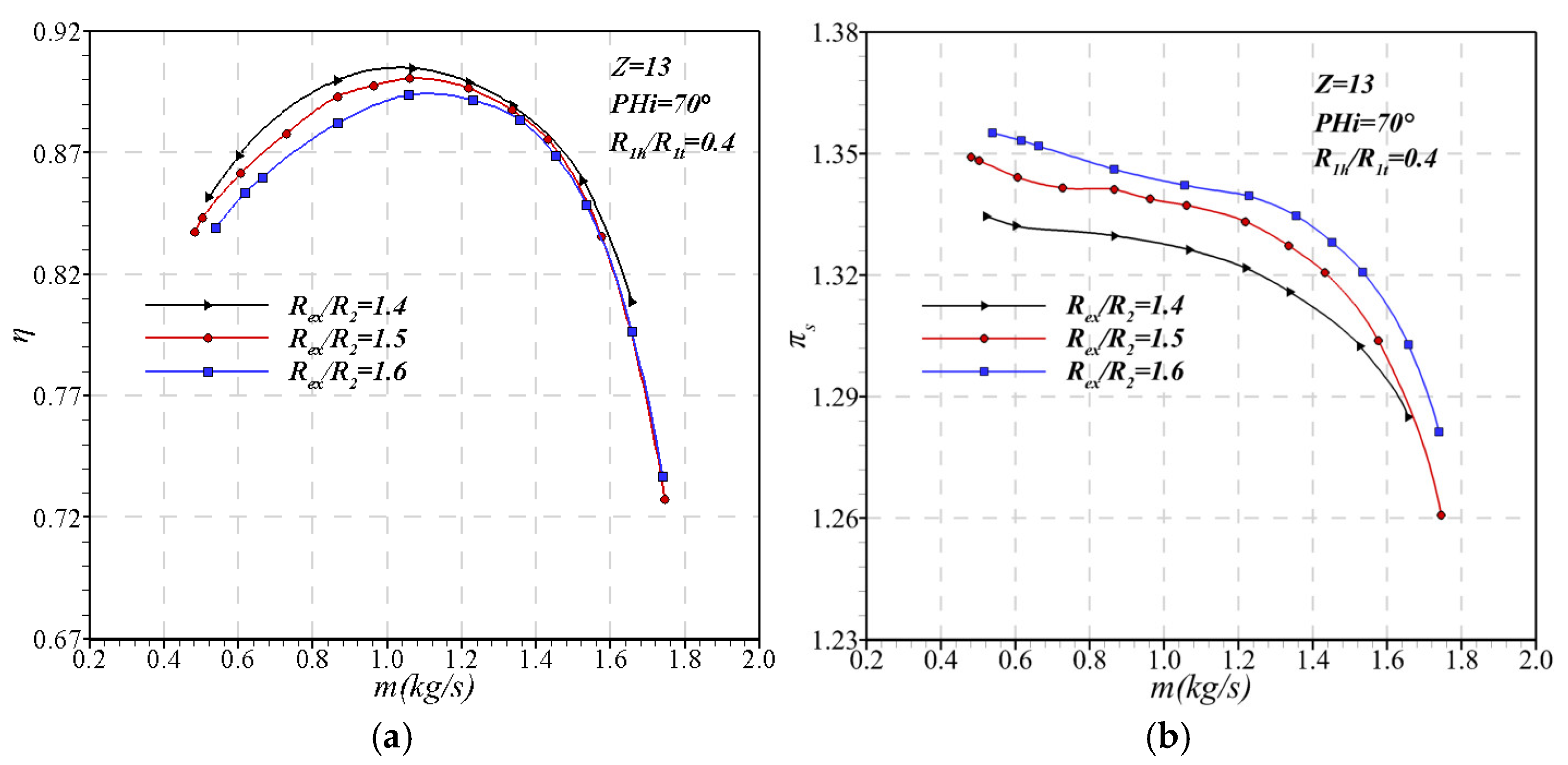

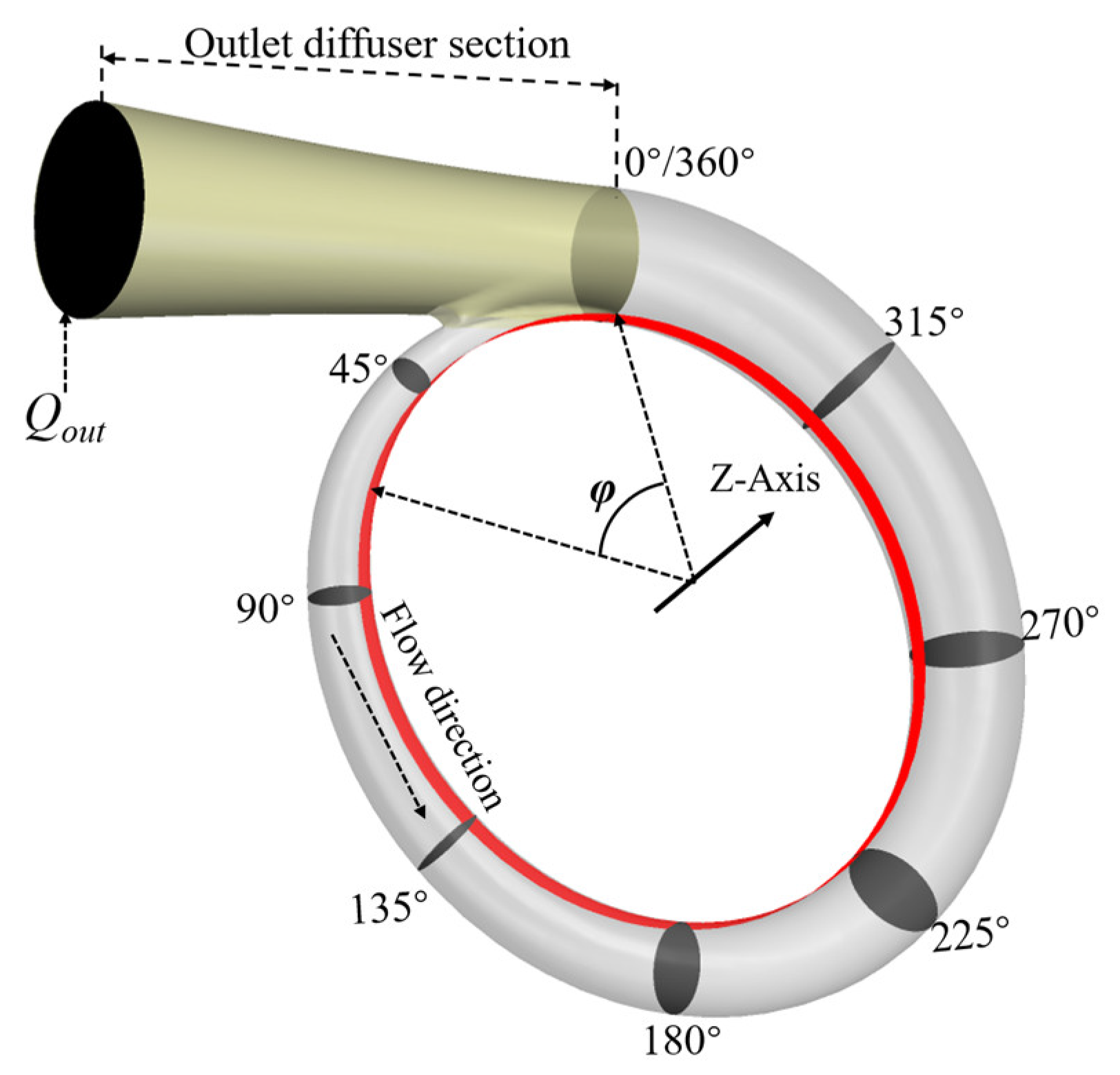
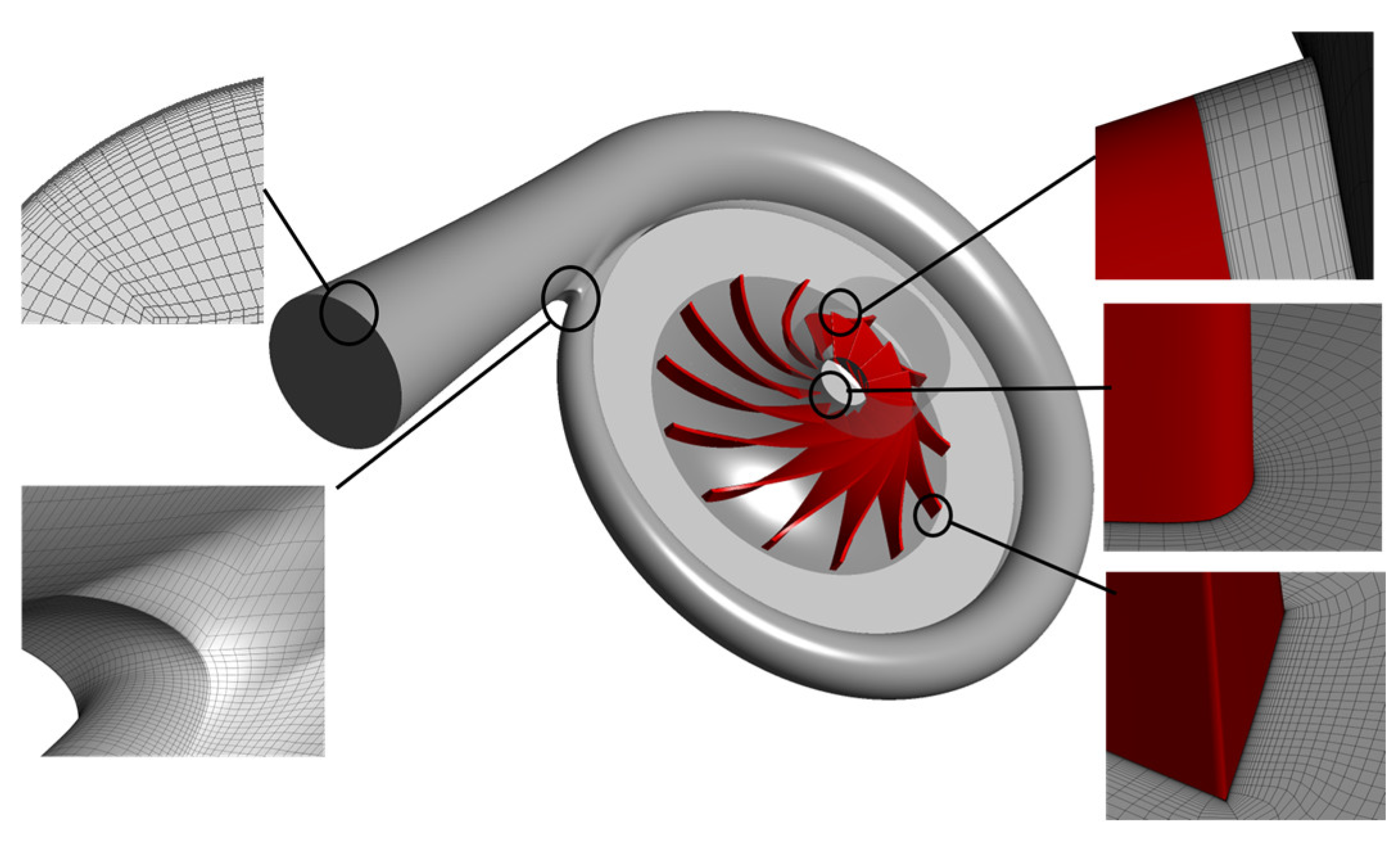
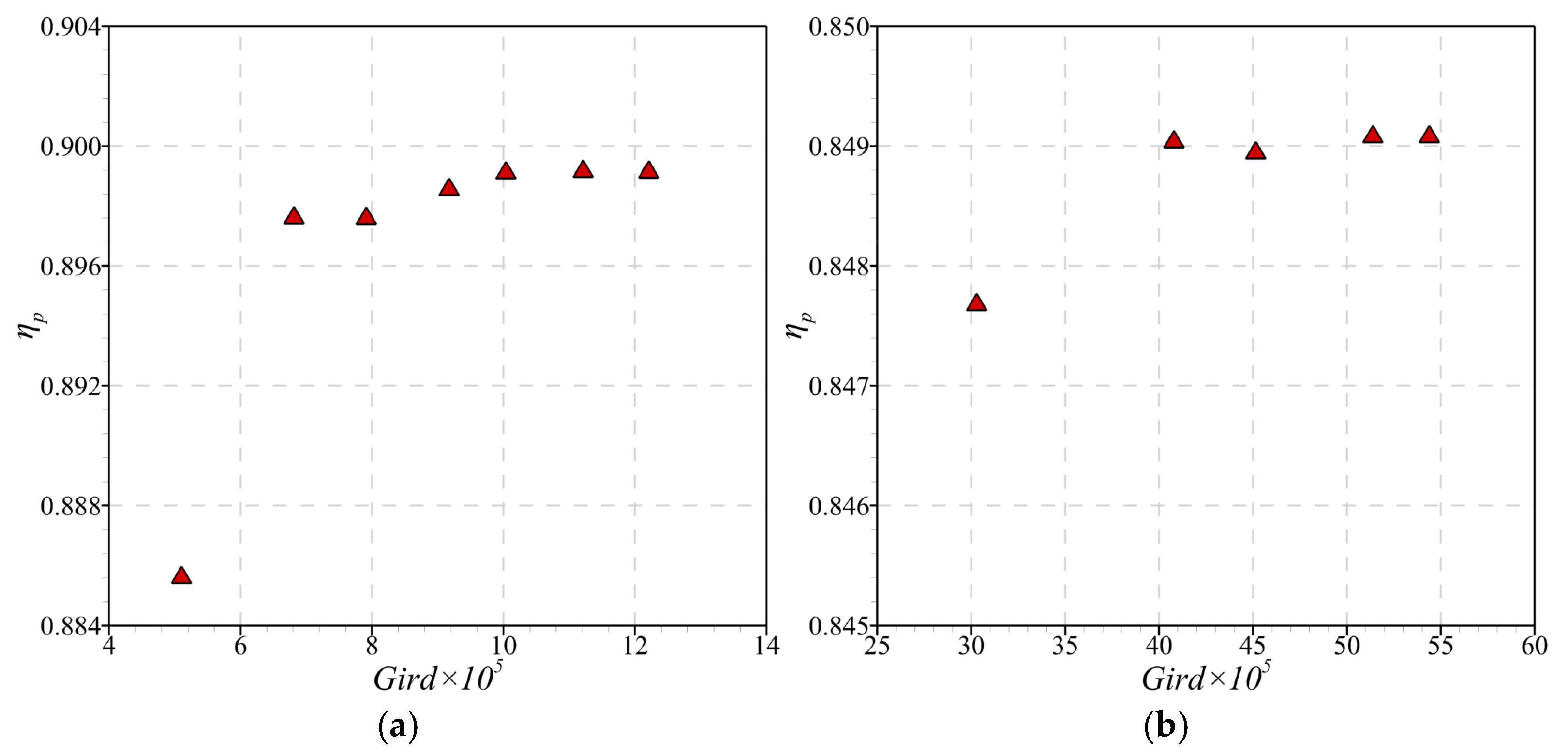
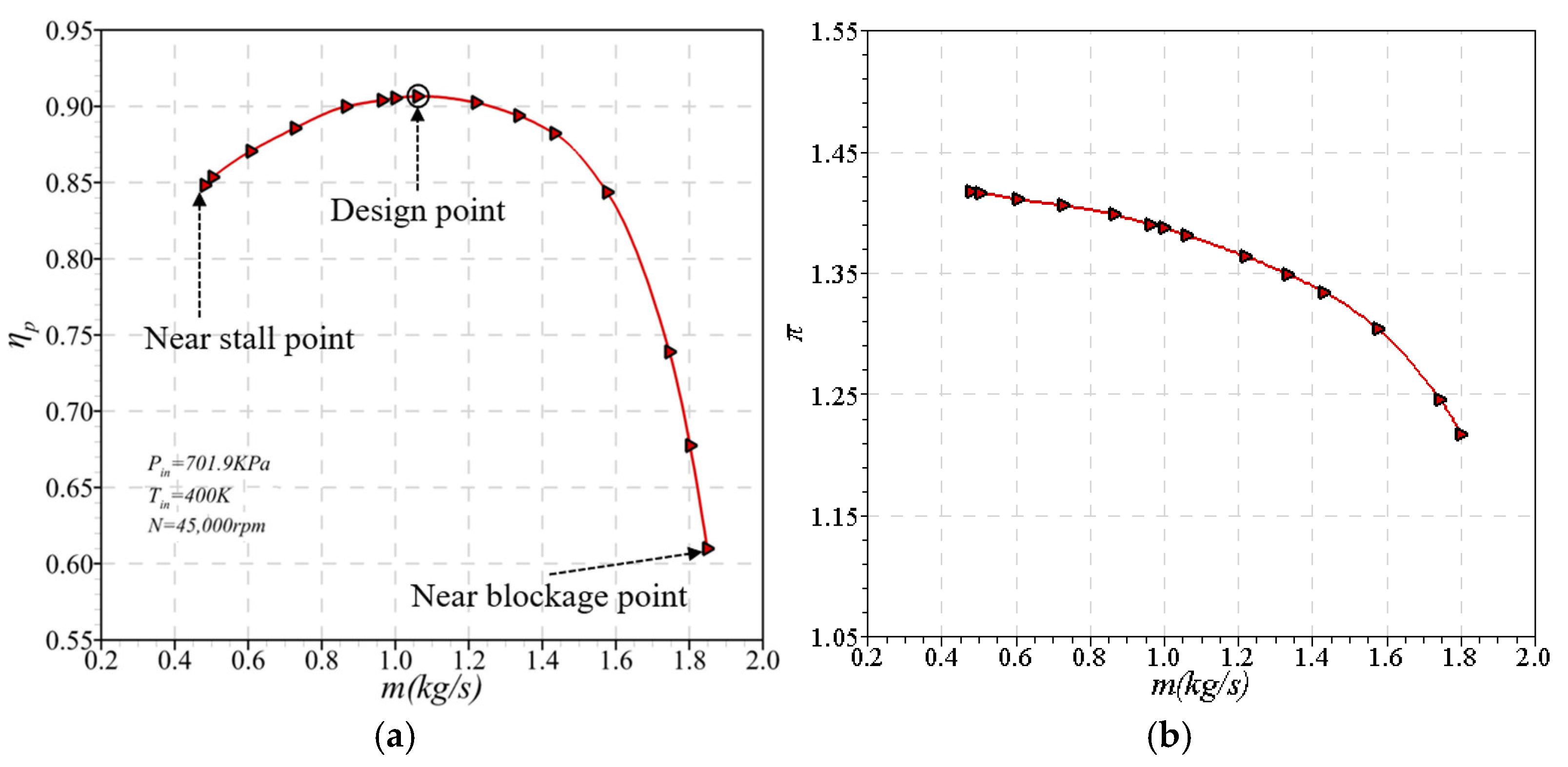

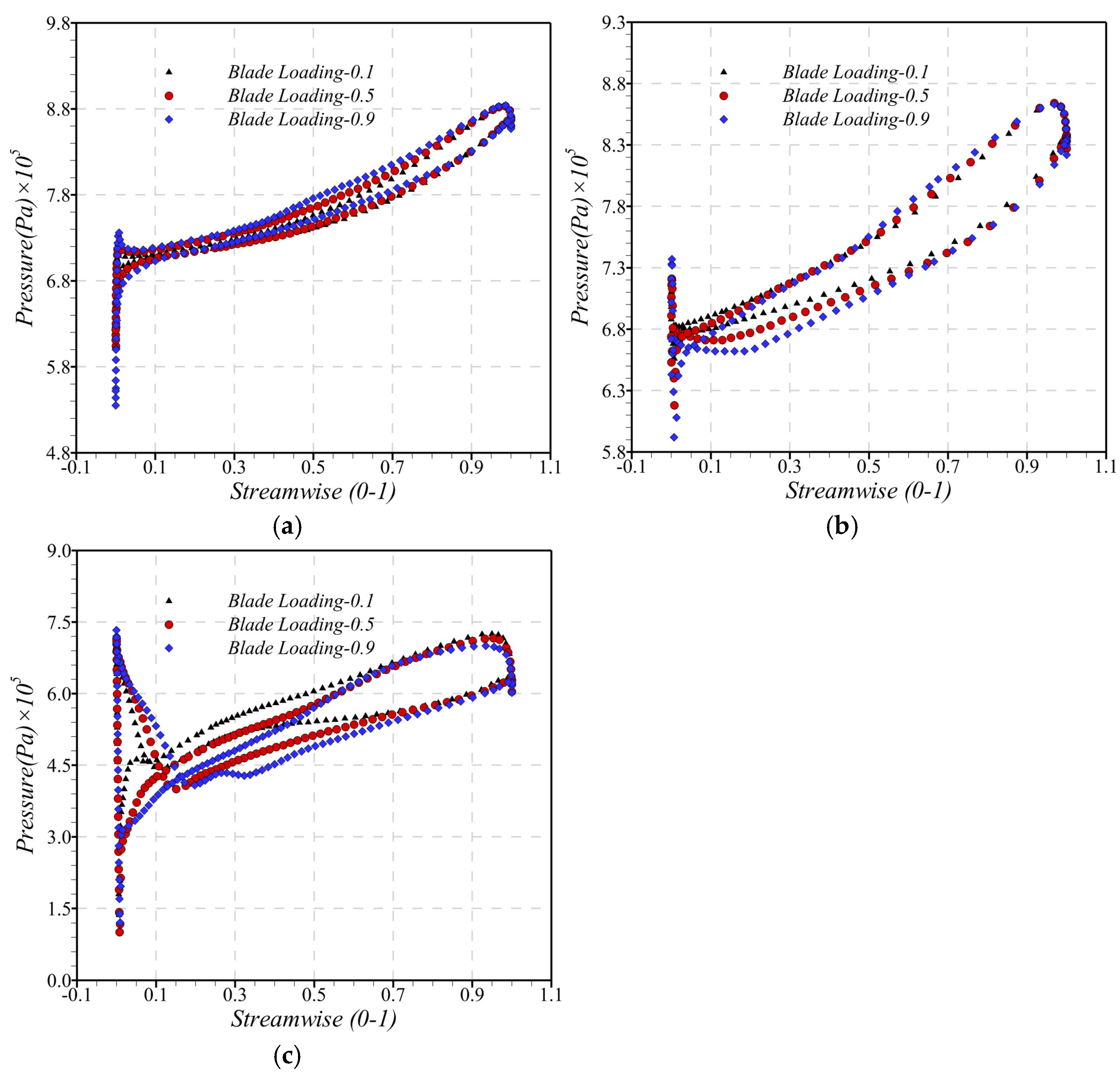
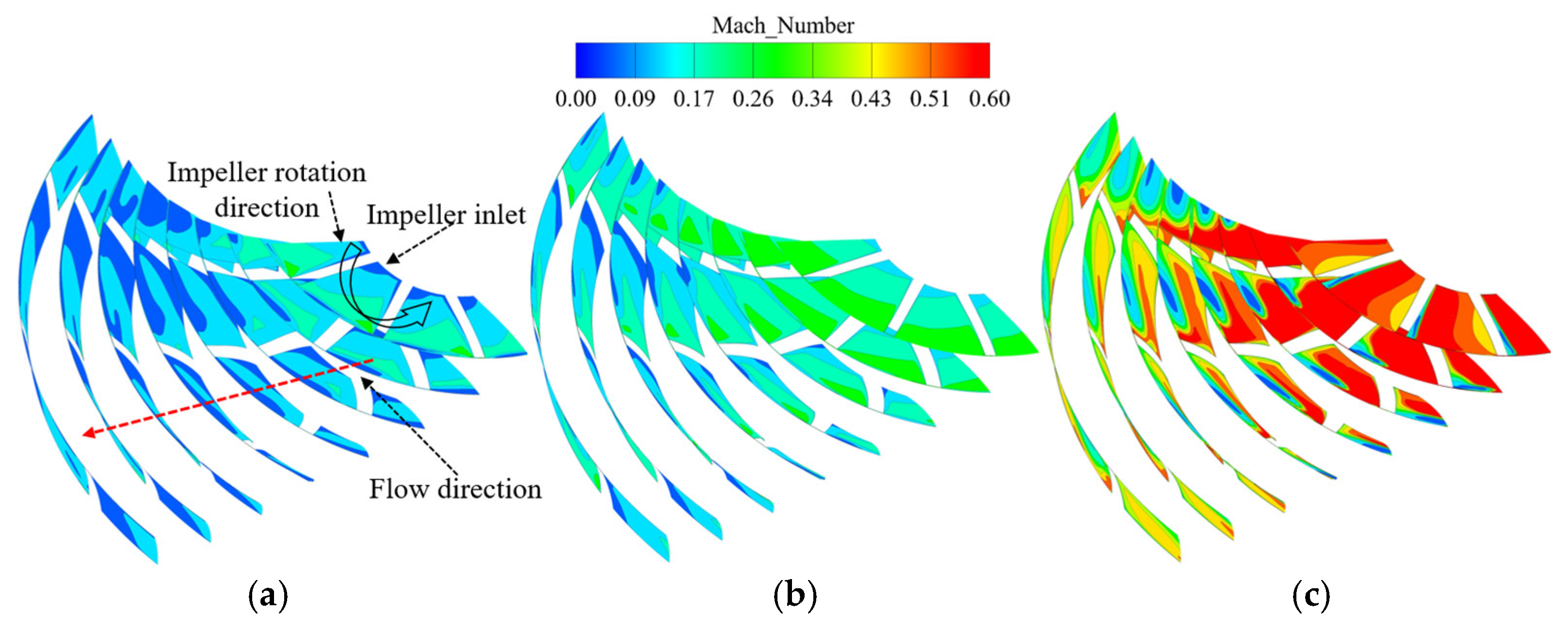

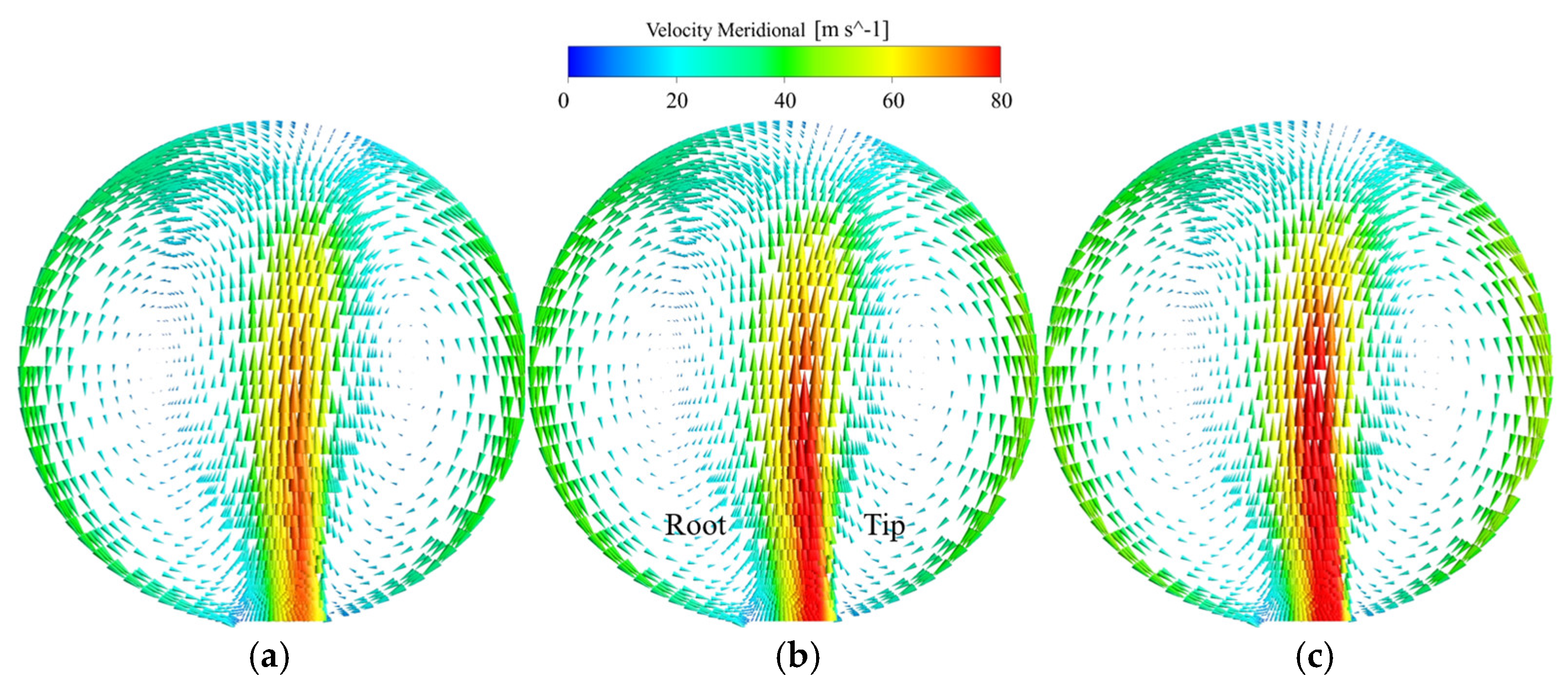
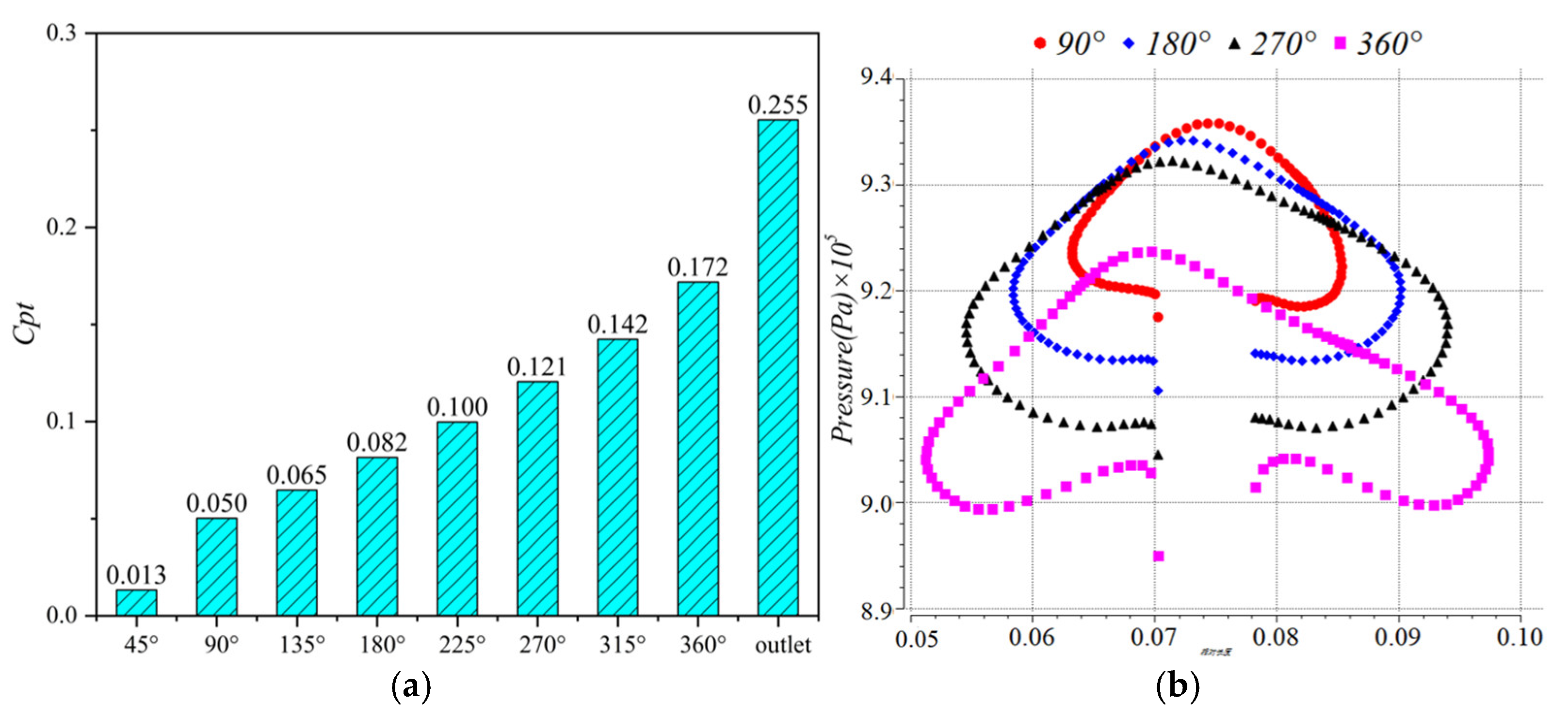
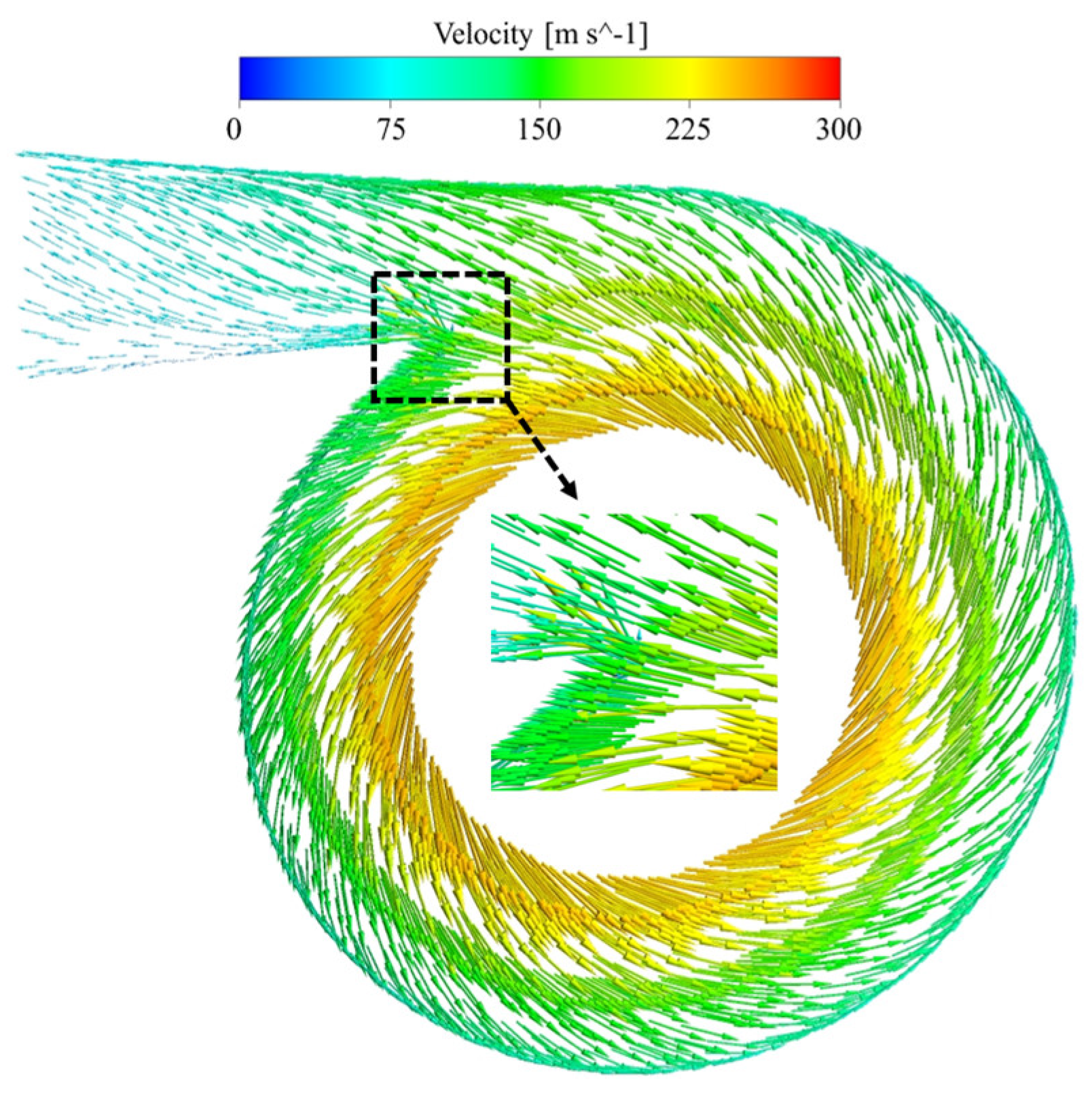


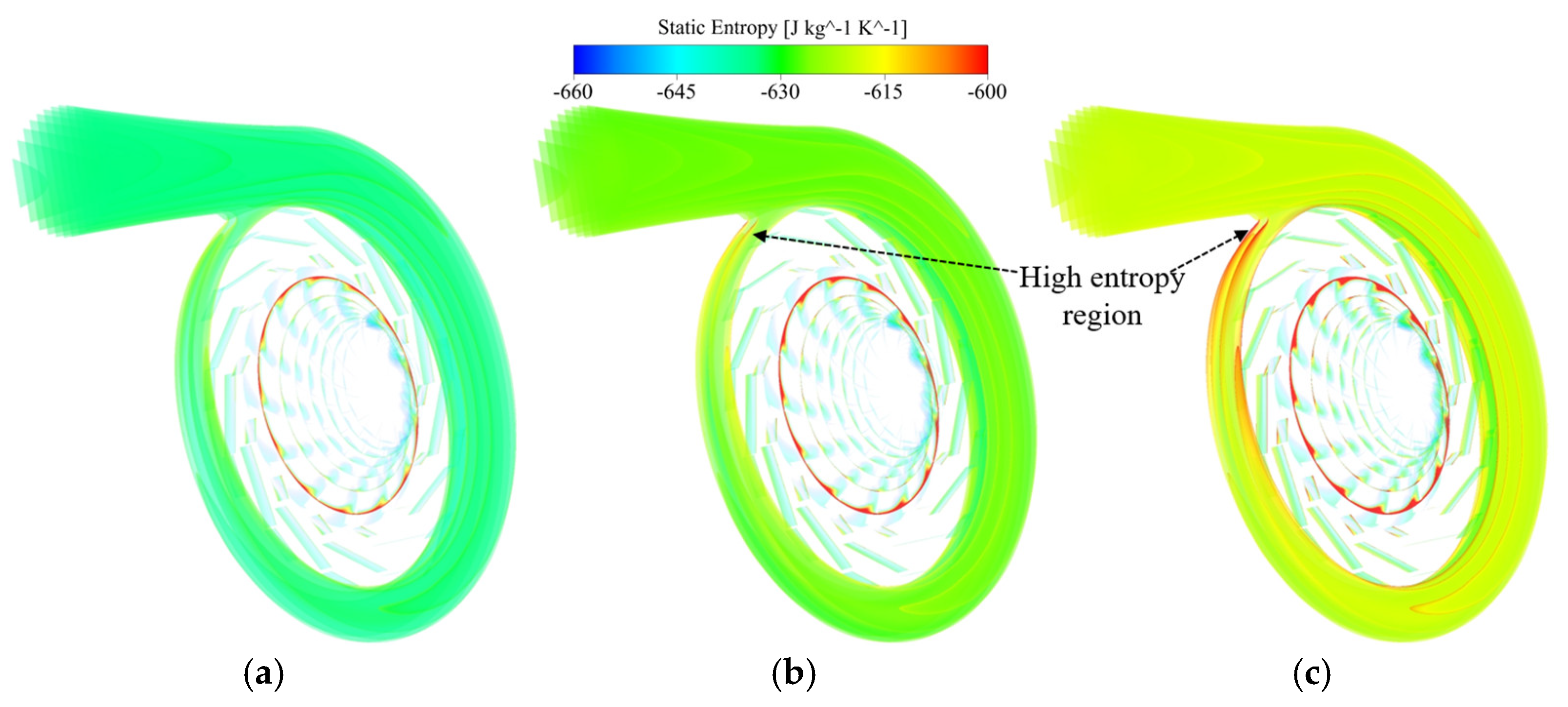
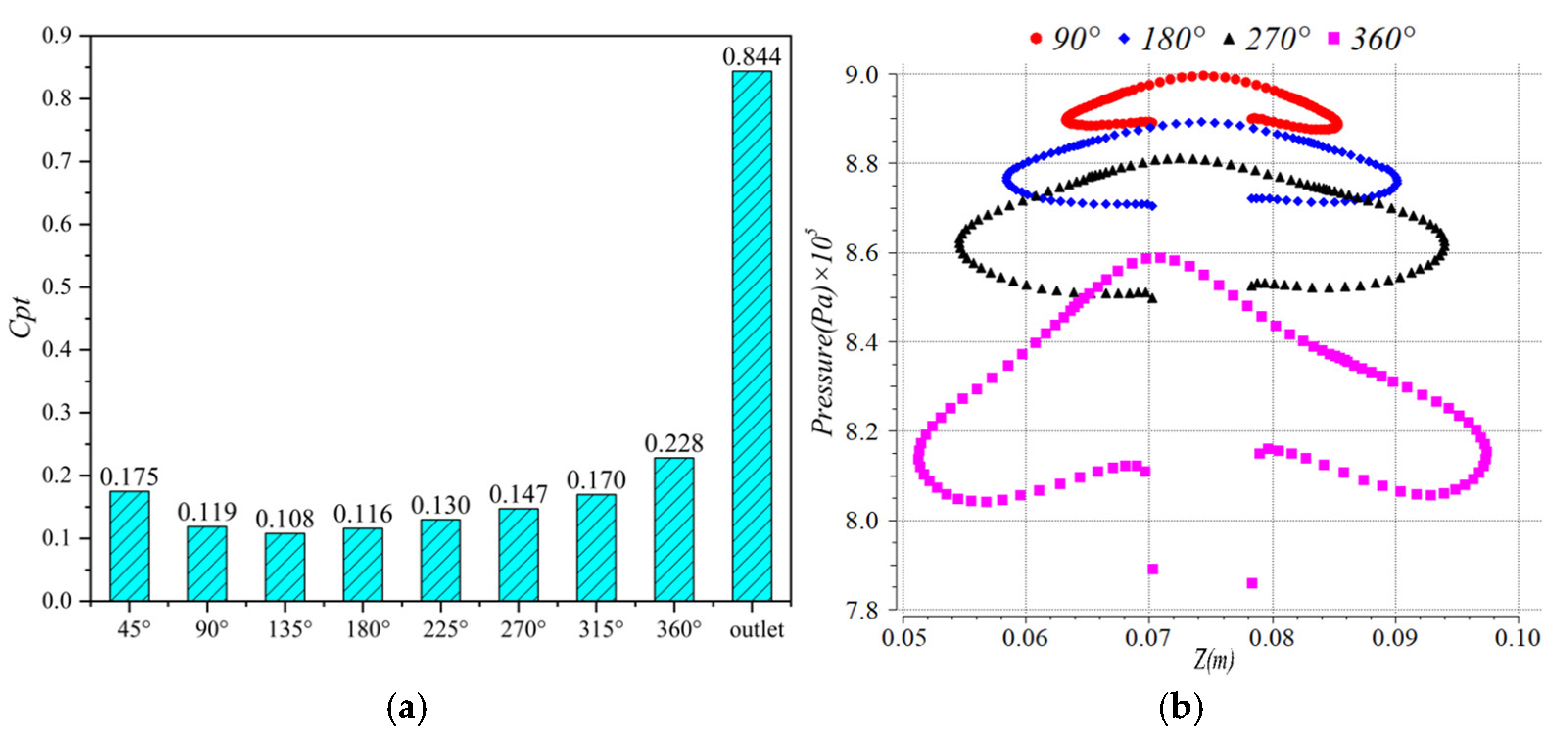
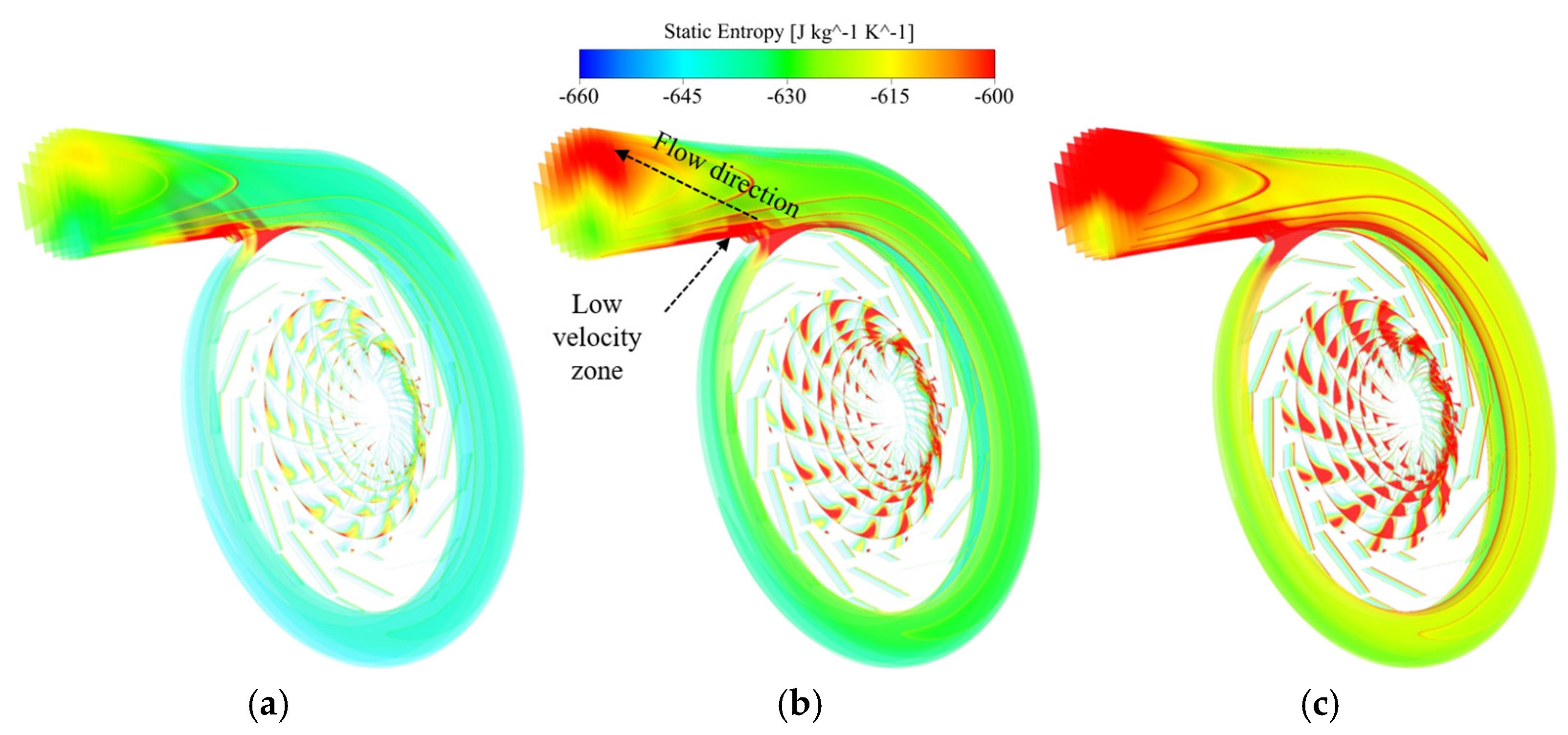
| Unit | He | Xe | Air | 40 g/mol | 15 g/mol | |
|---|---|---|---|---|---|---|
| Mean molal quantity | g/mol | 4.00 | 131.29 | 28.95 | 40.00 | 15.00 |
| Specific heat at constant pressure | J/(kg·K) | 5192.9 | 164.5 | 1020.0 | 520.9 | 1386.3 |
| Ratio of specific heat | - | 1.6658 | 1.7121 | 1.4022 | 1.6691 | 1.6663 |
| Thermal conductivity | W/(m·K) | 0.1909 | 0.0074 | 0.0332 | 0.0829 | 0.1437 |
| Dynamic viscosity | μPa·s | 24.3106 | 30.7514 | 23.1853 | 32.9888 | 30.2024 |
| Prandtl number | - | 0.6614 | 0.6851 | 0.7131 | 0.2073 | 0.2913 |
| Sound velocity | m/s | 1007.9 | 204.7 | 402.0 | 367.4 | 607.8 |
| Performance Parameter | Unit | Numerical Value |
|---|---|---|
| Inlet pressure | kPa | 701.9 |
| Entry temperature | K | 400 |
| Revolution speed | r/min | 45,000 |
| The flow of system operation | kg/s | 0.866 |
| Total pressure ratio | - | 1.34 |
| Performance Parameter | Unit | Numerical Value |
|---|---|---|
| Inlet pressure | kPa | 701.9 |
| Entry temperature | K | 400 |
| Revolution speed | r/min | 45,000 |
| Number of leaves | - | 13 |
| The flow of system operation | kg/s | 0.866 |
| Impeller inlet blade angle | ° | 39.81° |
| Impeller outlet blade angle | ° | 30.09° |
| The backbend angle of the impeller outlet | ° | −30° |
| Tip clearance | mm | 0.2 |
| Impeller compressor inlet hub radius | mm | 13.0 |
| Radius of compressor inlet rim | mm | 32.6 |
| Compressor outlet radius | mm | 72.6 |
| Diffuser outlet radius | mm | 108.9 |
| Performance Parameter | Unit | Numerical Value |
|---|---|---|
| Inlet pressure | kPa | 701.9 |
| Inlet temperature | K | 400 |
| Revolution speed | r/min | 45,000 |
| Number of leaves | - | 13 |
| The flow of system operation | kg/s | 0.866 |
| Impeller inlet blade angle | ° | 39.81° |
| Impeller outlet blade angle | ° | 30.09° |
| Slip coefficient | - | 0.864 |
| Impeller compressor inlet hub radius | mm | 13.0 |
| Radius of compressor inlet rim | mm | 32.6 |
| Compressor outlet radius | mm | 72.6 |
| Diffuser outlet radius | mm | 108.9 |
| Volute inlet diameter | mm | 217.9 |
| Volute casing inlet width | mm | 8.0 |
| Volute diffuser length | mm | 203.3 |
| Outlet diameter of volute diffusion tube | mm | 74.6 |
| The angle of the spiral line where the volute tongue is located | ° | 34.7 |
| Total pressure ratio | - | 1.368 |
| Isentropic efficiency | - | 83.94% |
| Polytropic efficiency | - | 84.9% |
Disclaimer/Publisher’s Note: The statements, opinions and data contained in all publications are solely those of the individual author(s) and contributor(s) and not of MDPI and/or the editor(s). MDPI and/or the editor(s) disclaim responsibility for any injury to people or property resulting from any ideas, methods, instructions or products referred to in the content. |
© 2024 by the authors. Licensee MDPI, Basel, Switzerland. This article is an open access article distributed under the terms and conditions of the Creative Commons Attribution (CC BY) license (https://creativecommons.org/licenses/by/4.0/).
Share and Cite
Zheng, J.; Tian, Z.; Malik, A.; Xin, J.; Lu, H. The Design and Performance Analysis of a 15 g/mol Helium–Xenon Mixture Centrifugal Compressor. Aerospace 2024, 11, 869. https://doi.org/10.3390/aerospace11110869
Zheng J, Tian Z, Malik A, Xin J, Lu H. The Design and Performance Analysis of a 15 g/mol Helium–Xenon Mixture Centrifugal Compressor. Aerospace. 2024; 11(11):869. https://doi.org/10.3390/aerospace11110869
Chicago/Turabian StyleZheng, Jinchao, Zhitao Tian, Adil Malik, Jianchi Xin, and Huawei Lu. 2024. "The Design and Performance Analysis of a 15 g/mol Helium–Xenon Mixture Centrifugal Compressor" Aerospace 11, no. 11: 869. https://doi.org/10.3390/aerospace11110869
APA StyleZheng, J., Tian, Z., Malik, A., Xin, J., & Lu, H. (2024). The Design and Performance Analysis of a 15 g/mol Helium–Xenon Mixture Centrifugal Compressor. Aerospace, 11(11), 869. https://doi.org/10.3390/aerospace11110869






